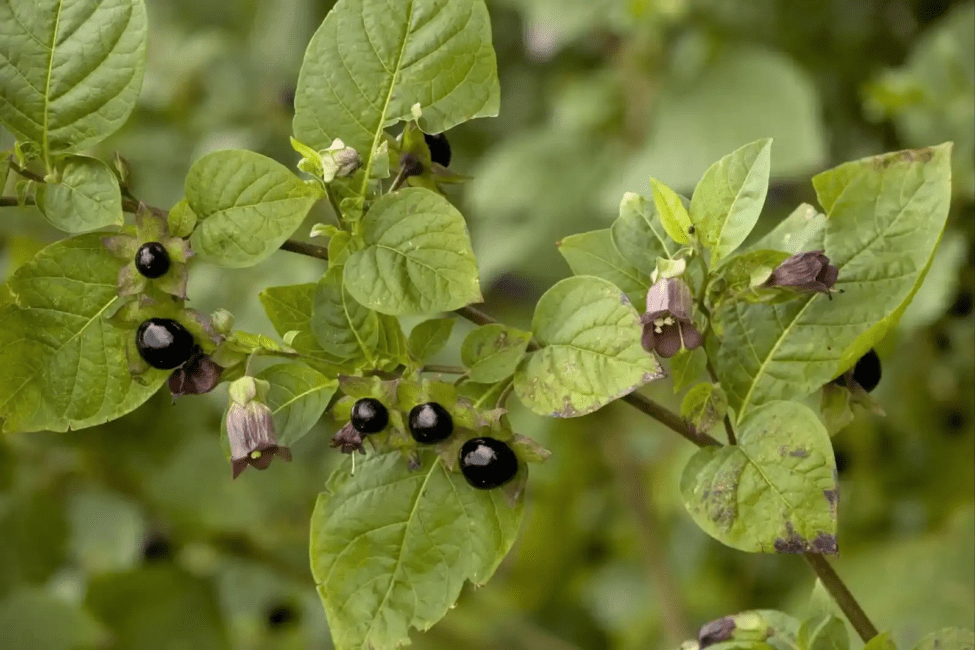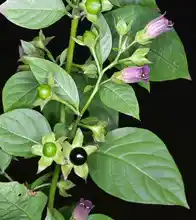19 Medicinal Health Benefits Of Belladonna (Deadly Nightshade)
Belladonna, scientifically known as Atropa belladonna, is a highly toxic plant that has been both feared and revered throughout history. Commonly referred to as Deadly Nightshade, belladonna belongs to the Solanaceae family and is native to Europe, North Africa, and Western Asia.
This perennial herbaceous plant is characterized by its dark green leaves, bell-shaped purple flowers, and shiny black berries.
The name belladonna is derived from Italian and means beautiful woman, alluding to the historical use of the plant in cosmetics and its association with dilating the pupils, which was once considered attractive.
Belladonna contains tropane alkaloids, including atropine, scopolamine, and hyoscyamine, which are highly toxic and can cause a range of severe symptoms, including hallucinations, blurred vision, increased heart rate, and respiratory failure. Ingesting even small amounts of belladonna can be fatal, and all parts of the plant, especially the berries, are toxic.
Despite its extreme toxicity, belladonna has a long history of use in traditional medicine, albeit with great caution. In the past, it was employed as a poison, medicine, and cosmetic. In medieval Europe, it was infamously associated with witchcraft and poisonings.
Additionally, belladonna has been used as a traditional remedy for various ailments, including motion sickness, asthma, and muscle spasms. However, due to its unpredictable and dangerous effects, its medical use is now largely obsolete, and safer alternatives are preferred.
In contemporary times, belladonna is primarily regarded as a toxic plant, and its cultivation and use are regulated in many places. The risks associated with belladonna poisoning have led to strict restrictions on its availability and use.
The Botanical Description of Belladonna
1. Leaves: Belladonna, scientifically known as Atropa belladonna, features large, ovate leaves arranged alternately along the stem. These dark green leaves, with a smooth texture, contribute significantly to the plant’s distinct appearance.
2. Flowers: Belladonna bears bell-shaped, purplish flowers that hang in a nodding fashion. Their solitary bloom adds to the allure of the plant, attracting attention due to its unique shape and coloration.
3. Fruit: The plant produces green berries that transform into shiny black ones when ripe. About the size of cherry tomatoes, these berries are toxic and should never be consumed despite their appealing appearance.
4. Stem: Belladonna’s robust, erect stem branches out, providing support for its leaves and flowers. Its growth pattern distinguishes it within the nightshade family.
The Geographic Distribution of Belladonna
1. Native Regions: Belladonna is native to Europe, favoring wooded areas with a temperate climate and soils rich in limestone. It’s also found in parts of Asia and North Africa.
2. Cultivation Worldwide: This plant is cultivated in various regions worldwide, including gardens and medicinal herb plots. However, caution must be exercised due to its toxicity.
3. Environmental Conditions: Thriving in partial shade and well-drained soil, Belladonna adapts to various conditions, preferably alkaline soils.
The Chemical Composition of Belladonna
1. Alkaloids: Atropine, hyoscyamine, and scopolamine are significant alkaloids present in Belladonna, contributing to its toxicity and medicinal properties.
2. Tropane Alkaloids: These compounds impact the nervous system and are a notable class of alkaloids found in Belladonna.
3. Flavonoids: Belladonna contains flavonoids, known for their antioxidant properties, adding to its chemical diversity.
4. Essential Oils: Trace amounts of essential oils in Belladonna contribute to its aromatic characteristics.
Read Also: 15 Medicinal Health Benefits Of Tarragon (Artemisia dracunculus)
The Medicinal Health Benefits Of Belladonna (Deadly Nightshade)

1. Pain Relief: Belladonna has analgesic properties that can help alleviate pain, making it valuable in certain medical applications.
2. Respiratory Conditions: It is used to treat respiratory issues such as asthma and bronchitis, thanks to its ability to relax airways.
3. Anti-Spasmodic: Belladonna acts as an antispasmodic, easing muscle spasms and contractions, providing relief for conditions like irritable bowel syndrome.
4. Motion Sickness: The plant can help alleviate symptoms of motion sickness due to its impact on the nervous system.
5. Parkinson’s Disease: Some studies suggest that Belladonna may have potential in managing symptoms associated with Parkinson’s disease.
6. Gastrointestinal Disorders: Belladonna is utilized in treating certain gastrointestinal disorders, aiding in digestive processes.
7. Anti-Inflammatory: Its anti-inflammatory properties make it useful in reducing inflammation associated with various health issues.
8. Fever Reduction: Belladonna has been historically used to lower fever in certain medical traditions.
9. Muscle Spasms: The plant’s muscle-relaxant qualities make it effective in treating muscle spasms and related conditions.
10. Eye Conditions: Belladonna has been employed to dilate the pupils for eye examinations and to manage certain eye conditions.
11. Parkinson’s Disease: Emerging research suggests potential benefits in managing symptoms of Parkinson’s disease.
12. Nervous System Disorders: It may be beneficial in certain nervous system disorders due to its impact on neural pathways.
13. Anti-Anxiety: Belladonna has properties that may contribute to anxiety reduction in specific contexts.
14. Menstrual Disorders: Some applications involve the use of Belladonna to alleviate symptoms of menstrual disorders.
15. Anti-Microbial: It exhibits antimicrobial properties, potentially aiding in the treatment of certain infections.
16. Sedative: In controlled and minimal doses, Belladonna may act as a sedative, promoting relaxation.
17. Anti-Convulsant: It shows promise as an anti-convulsant, assisting in the management of seizures.
18. Dermatological Applications: Belladonna has been used topically for certain skin conditions due to its potential anti-inflammatory effects.
19. Joint Pain: Belladonna may offer relief from joint pain associated with certain inflammatory conditions.
The Methods of Usage to Achieve the Provided Health Benefits Of Belladonna (Deadly Nightshade)
1. Tinctures: Tinctures are commonly used to extract and administer Belladonna in controlled doses for medicinal purposes.
2. Topical Applications: Ointments and creams containing Belladonna are used for localized relief, especially in dermatological conditions.
3. Inhalation: For respiratory benefits, inhaling vaporized Belladonna is a method used to target respiratory issues.
4. Homeopathic Remedies: In homeopathy, Belladonna is diluted to create remedies addressing various health concerns.
5. Eye Drops: In ophthalmology, controlled and diluted Belladonna is used in eye drops for specific medical procedures.
6. Oral Medications: Belladonna can be consumed orally, often in the form of tablets or capsules, for systemic effects.
7. Plasters: External plasters with Belladonna are applied to the skin to address muscular pain and spasms.
8. Poultices: Poultices are sometimes used for localized relief, particularly for conditions like joint pain.
The Side Effects Of Using Belladonna Medicinal Plant
1. Toxicity: Belladonna is highly toxic, and even small amounts can lead to severe poisoning if not administered with extreme caution.
2. Dry Mouth: One common side effect is dry mouth, a result of Belladonna’s impact on salivary glands.
3. Blurred Vision: Pupillary dilation caused by Belladonna can lead to blurred vision, affecting eyesight temporarily.
4. Delirium: Excessive use may lead to delirium and hallucinations due to its impact on the central nervous system.
5. Increased Heart Rate: Belladonna can cause an increase in heart rate, posing risks for individuals with cardiovascular conditions.
6. Constipation: Gastrointestinal side effects include constipation, impacting regular bowel movements.
7. Urinary Retention: Belladonna may interfere with normal bladder function, leading to urinary retention.
8. Sensitivity to Light: Pupil dilation may result in heightened sensitivity to light, causing discomfort.
9. Nausea and Vomiting: Some individuals may experience nausea and vomiting, particularly if Belladonna is consumed in excess.
10. Agitation: Excessive use can lead to agitation and restlessness, affecting mental well-being.
11. Allergic Reactions: Allergic reactions, though rare, can occur and may manifest as skin rashes or respiratory distress.
12. Respiratory Distress: Inhaled Belladonna can cause respiratory distress, especially in sensitive individuals.
13. Cognitive Impairment: Prolonged use or high doses may lead to cognitive impairment and confusion.
14. Interactions with Medications: Belladonna may interact with certain medications, potentially amplifying side effects.
15. Risk of Overdose: Due to its toxicity, there is a risk of overdose with Belladonna, emphasizing the need for precise dosing and professional supervision.
Read Also: Agribusiness: More Ways to Earn a Living from Farming Minus Land
The Scientific Research and Studies of Belladonna

1. Pain Management Studies: Scientific research has explored Belladonna’s efficacy in managing pain, particularly in conditions like migraines and neuralgia.
2. Respiratory Health Investigations: Studies have delved into the impact of Belladonna on respiratory health, examining its potential benefits for conditions such as asthma and bronchitis.
3. Neurological Studies: Belladonna’s effects on the nervous system have been a focal point in research, investigating its potential in neurological disorders like Parkinson’s disease.
4. Anti-Spasmodic Properties: The antispasmodic properties of Belladonna have been scientifically examined, shedding light on its use in alleviating muscle spasms and related conditions.
5. Gastrointestinal Applications: Research has explored the benefits of Belladonna in treating certain gastrointestinal disorders, emphasizing its role in digestive health.
6. Anti-Inflammatory Effects: Scientific studies have investigated the anti-inflammatory effects of Belladonna, uncovering its potential in reducing inflammation associated with various health issues.
7. Fever-Reducing Properties: The historical use of Belladonna for fever reduction has been subject to scientific scrutiny, evaluating its effectiveness in controlled settings.
8. Antimicrobial Properties: The antimicrobial properties of Belladonna have been studied, providing insights into its potential applications in managing infections.
9. Dermatological Investigations: Scientific research has explored the dermatological applications of Belladonna, particularly in addressing certain skin conditions.
10. Antioxidant Effects: Studies have investigated the flavonoids in Belladonna, highlighting its antioxidant effects and potential benefits for overall health.
11. Sedative Qualities: Controlled studies have examined the sedative qualities of Belladonna, offering insights into its potential role in promoting relaxation.
12. Anti-Convulsant Potential: Research has explored the anti-convulsant potential of Belladonna, suggesting a possible application in managing seizures.
The Safety Precautions and Recommendations In Using Belladonna Medicinal Plant
1. Professional Guidance: Seek guidance from healthcare professionals before using Belladonna, especially for those with pre-existing medical conditions.
2. Dosage Accuracy: Accurate dosing is crucial due to Belladonna’s toxicity; adhere strictly to recommended dosage guidelines.
3. Avoid Self-Diagnosis: Do not use Belladonna for self-diagnosis; consult a healthcare professional for an accurate assessment of health conditions.
4. Allergic Reactions: Monitor for allergic reactions and discontinue use if rash, swelling, or respiratory distress occurs.
5. Interaction with Medications: Be cautious of potential interactions with other medications, and inform healthcare providers of all substances being used.
6. Not for Children: Avoid using Belladonna in children without explicit guidance from a pediatrician due to its potent effects.
7. Pregnancy and Nursing: Pregnant and nursing individuals should consult healthcare providers before considering Belladonna use.
8. Avoid Prolonged Use: Prolonged use of Belladonna may lead to adverse effects; use under professional supervision.
9. Keep Out of Reach of Children: Due to its toxicity, Belladonna products should be stored securely, away from the reach of children.
10. No DIY Extraction: Avoid attempting to extract Belladonna compounds at home; use only commercially available and professionally prepared products.
11. Monitoring Side Effects: Regularly monitor for side effects such as dry mouth, blurred vision, or increased heart rate during usage.
12. Emergency Contacts: Have emergency contact information readily available in case of adverse reactions; seek immediate medical attention if needed.
FAQs About Belladonna Medicinal Plant
1. Can Belladonna be used for pain relief?
Yes, Belladonna has analgesic properties and is used in certain conditions for pain management.
2. Is Belladonna safe for children?
It is not recommended for children without explicit guidance from a pediatrician due to its potency.
3. How should Belladonna be stored?
Store Belladonna securely, away from children, and in a cool, dry place.
4. Can Belladonna be used during pregnancy?
Pregnant individuals should consult healthcare providers before considering Belladonna use.
5. Are there specific dosage guidelines for Belladonna?
Accurate dosing is crucial, and guidelines should be strictly followed to prevent toxicity.
6. Can Belladonna be applied topically?
Yes, ointments and creams containing Belladonna are used for localized relief.
7. Are there any reported allergic reactions to Belladonna?
Allergic reactions are rare but can include skin rashes or respiratory distress.
8. What are the signs of Belladonna overdose?
Symptoms may include delirium, blurred vision, increased heart rate, and gastrointestinal distress.
9. Can Belladonna be used as a sedative?
In controlled and minimal doses, Belladonna may act as a sedative, promoting relaxation.
10. Is there a risk of interactions with other medications?
Yes, Belladonna may interact with certain medications, emphasizing the importance of medical consultation.
11. How quickly does Belladonna take effect for pain relief?
The onset of action can vary; it is recommended to follow professional advice on usage.
12. Are there specific precautions for individuals with heart conditions?
Individuals with cardiovascular conditions should exercise caution due to the potential increase in heart rate.
13. Can Belladonna be used for skin conditions?
Yes, topical applications of Belladonna are employed for certain dermatological conditions.
14. Is Belladonna addictive?
No, Belladonna is not known to be addictive; however, it should be used cautiously due to its toxicity.
15. What should be done in case of a suspected Belladonna overdose?
Seek immediate medical attention and provide details of the suspected overdose for appropriate intervention.
Read Also: Top 10 Vegetable Crops to Grow in Your Backyard









